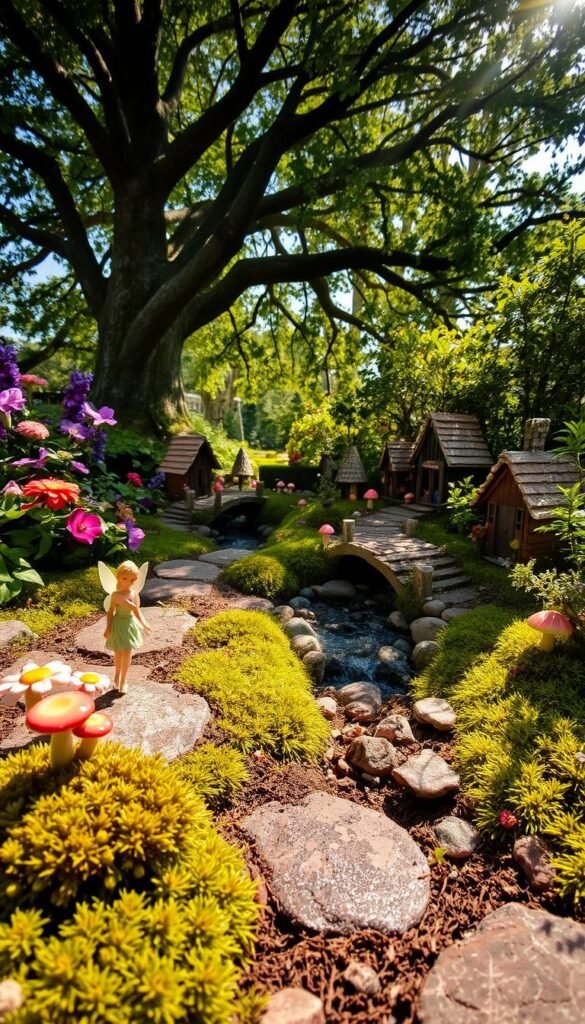Imagine turning an old planter or empty corner into a living storybook scene. Fairy gardens let you craft magical worlds using small plants, miniature accessories, and everyday creativity. These pint-sized landscapes work equally well on apartment balconies or backyard patios, blending gardening with imaginative play.
You don’t need expert skills to start. Whether repurposing a teacup or designing an elaborate woodland scene, these tiny ecosystems adapt to your space and vision. Many enthusiasts find the process relaxing – a chance to unplug while shaping mossy pathways or arranging pebble borders.
What makes these gardens special? They grow and change like characters in a story. A sprouting thyme plant becomes a forest canopy. Weatherworn stones transform into mystical portals. This evolving quality keeps both kids and adults engaged season after season.
Our guide walks through each step: choosing containers, selecting hardy plants, and adding personality with tiny decorations. You’ll learn how to create depth in small spaces and maintain your miniature paradise. Let’s explore how to turn ordinary materials into something extraordinary.
Beyond being decorative, these living art projects connect you with nature’s rhythms. Watering tiny ferns becomes a mindful ritual. Watching succulents spread feels like collaborating with the earth itself. Ready to craft your own pocket-sized retreat?
Discover the Magic of Mini Fairy Gardens
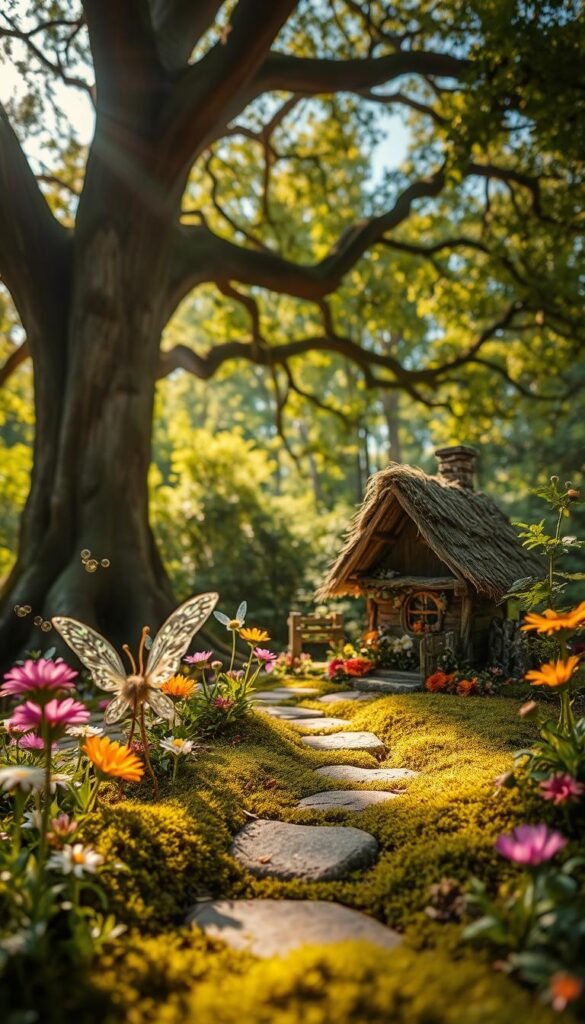
Step into a world where tiny mushrooms become towering trees and pebbles transform into mystical pathways. These magical fairy garden creations blend horticulture with storytelling, inviting you to design living dioramas that spark joy. Rooted in folklore, they’re believed to attract playful fairies while offering a creative escape from daily routines.
Miniature landscapes let you experiment with scale in surprising ways. A teacup becomes a bubbling pond. Moss carpets turn into lush meadows. This playful perspective turns small spaces into expansive worlds, merging artistry with nature’s growth cycles. Many find arranging miniature fairy gardens and houses meditative – each pebble placement becomes a mindful moment.
| Fairy Garden Benefit | How It Works | Emotional Impact |
|---|---|---|
| Creative Expression | Mix plants, stones & decor | Boosts imagination |
| Mindful Focus | Detailed arranging | Reduces stress |
| Seasonal Changes | Plants grow, decor weathers | Encourages observation |
| Social Connection | Shared with visitors | Creates wonder |
What makes these fairy gardens truly special? They evolve like living stories. Thyme sprouts become forest canopies. Rain patinas tiny benches, adding character. This constant transformation keeps creators engaged through every season.
Whether crafting solo or with family, these spaces rekindle childhood curiosity. Adults appreciate the sophisticated blend of design and botany, while kids adore the hidden surprises. Your finished masterpiece becomes more than decor – it’s a conversation starter that spreads smiles.
Understanding What is a Fairy Garden
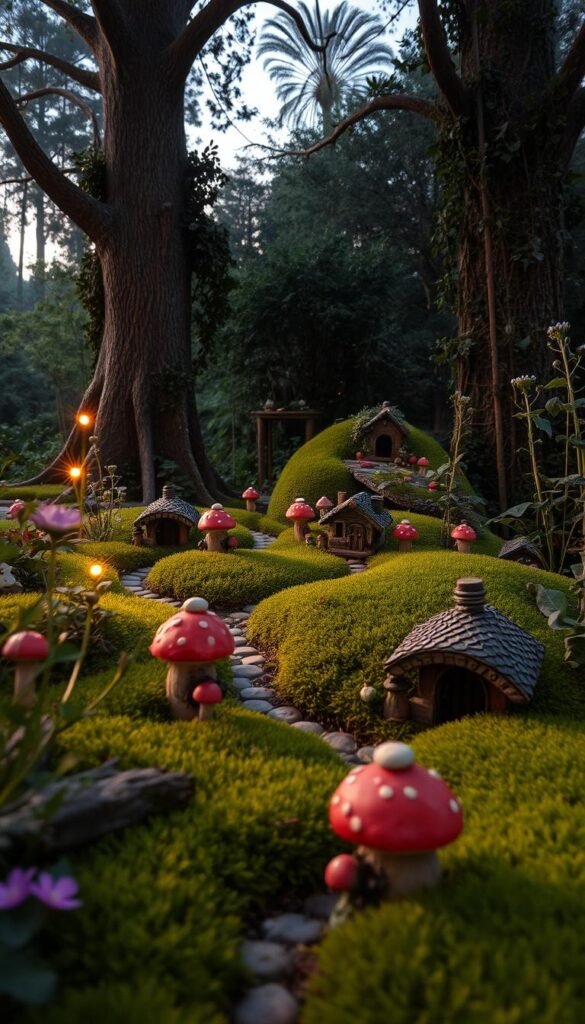
Picture a world where tiny cottages nestle between mossy hills, and pebble trails lead to secret clearings. These fairy gardens blend living greenery with crafted details to create scenes straight from folklore. Unlike regular planters, they tell visual stories through carefully chosen elements.
Defining the Enchanted Space
A true fairy garden combines three essentials: scale-appropriate plants, decorative structures, and narrative flow. Dwarf shrubs become towering trees. Miniature benches suggest hidden residents. Every piece works together to create depth in small spaces.
| Core Element | Purpose | Example |
|---|---|---|
| Living Plants | Create natural scenery | Thyme, moss, succulents |
| Structures | Suggest habitation | Mini cottages, bridges |
| Pathways | Guide exploration | Gravel, crushed shells |
| Decorations | Add magic | Tiny mushrooms, glittering stones |
The Folklore Behind Fairies and Miniatures
Ancient Celtic traditions believed fairies inhabited wild places like hawthorn groves. Modern designs echo this by using natural materials. Miniature scenes let us interact with these myths physically.
Humans have crafted tiny worlds for centuries – from Victorian fern cases to Japanese bonkei. Today’s gardens satisfy our need to shape nature playfully. They offer control over beauty in chaotic times.
When you arrange a tiny watering can or position a fairy door, you’re continuing a tradition older than written history. These spaces let imagination and reality dance together – just as they did for our ancestors.
Exploring the History and Inspiration

Long before tiny cottages dotted tabletops, people crafted miniature worlds to connect with nature’s mysteries. Early Celtic communities believed fairies dwelled in wild spaces—twisted hawthorn trees, mossy springs, and mushroom rings. These sacred spots inspired the first plant-filled arrangements meant to welcome mystical visitors.
From Folklore to Modern Miniatures
Victorian-era gardeners popularized tiny landscapes in glass terrariums, blending ferns with porcelain figurines. By the 1920s, America’s love for dollhouses and model trains sparked a miniatures craze that shaped today’s gardening trends. Craft stores began selling tiny tools, letting anyone create detailed scenes.
| Era | Influence | Modern Impact |
|---|---|---|
| Ancient Celtic | Natural fairy habitats | Mossy ground covers |
| Victorian | Terrarium designs | Indoor gardens |
| 1920s America | Miniature movement | Scaled accessories |
Contemporary designs merge these traditions with DIY garden art techniques. What started as outdoor shrines now thrive on windowsills and desks. Advances in succulent propagation allow intricate living sculptures once impossible to maintain.
Your garden carries echoes of ancient beliefs—each thyme sprig a forest, every pebble path a story. As lifestyles shifted to smaller spaces, these mini worlds adapted, proving magic grows best when shared.
Planning Your Fairy Garden Space
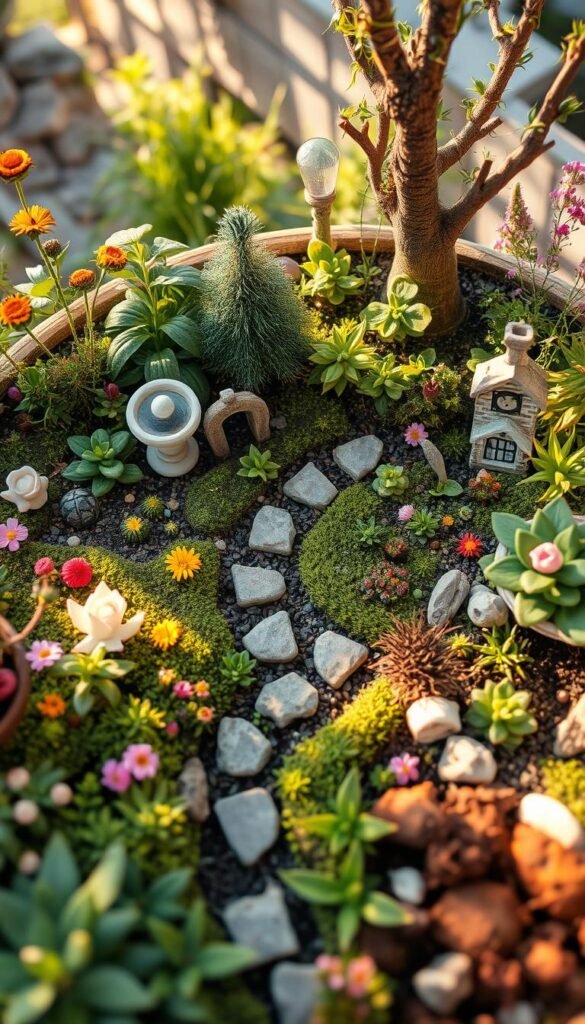
Transform ordinary corners into enchanted realms by first mapping your miniature masterpiece. Successful fairy gardens balance size and theme – sketch rough dimensions to visualize how plants and decor will interact. This prep work prevents overcrowding and ensures every tiny bench or winding path serves a purpose.
Sketching Your Design
Grab graph paper or use a digital app to outline your garden space. Mark where structures like cottages or bridges will anchor the scene. Leave room for plants to grow – dwarf varieties need at least 2″ between them. Curved pathways create depth, while elevated areas add dimension to flat containers.
Choosing the Ideal Location
Sunlight dictates your plant roster. Morning sun with afternoon shade suits ferns and mosses, while succulents thrive in full glare. Test spots by observing light patterns for 3 days. Avoid areas where rainwater pools – proper drainage keeps roots healthy. Nestle your outdoor space near trees or walls for wind protection and storytelling potential.
Remember: shady zones let you craft mysterious groves with velvet moss carpets. Sunny plots shine with colorful sedum “flowers” and quartz crystal accents. Match your theme to the location’s natural advantages for a garden that feels both magical and perfectly at home.
Selecting the Perfect Garden Container
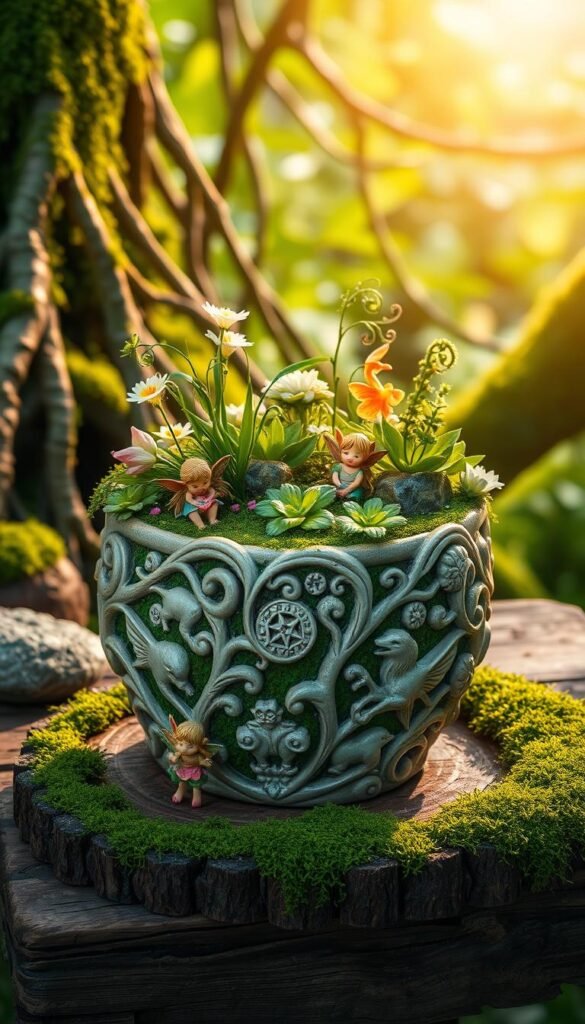
Your container isn’t just a pot – it’s the stage where your miniature story unfolds. Portable garden containers let you move magic wherever needed, from sunny windowsills to shaded patios. They protect delicate plants during storms and let you refresh designs easily.
Consider these factors when choosing:
- Drainage: Drill holes in non-porous materials
- Depth: 6-8” soil for root growth
- Material: Weather-resistant options last longer outdoors
Terra cotta pots breathe naturally, while vintage crates add rustic charm. Upcycle teacups or wagons by lining them with landscape fabric. One gardener transformed an old birdbath into a cascading fairy garden with sedums spilling over its edges.
| Material | Best For | Care Tip |
|---|---|---|
| Wood | Woodland themes | Seal with waterproof stain |
| Ceramic | Indoor displays | Use saucers to catch drips |
| Metal | Modern designs | Add insulation in winter |
Shallow containers work for rock gardens, while deeper ones suit miniature trees. Leave 30% empty space for decor arrangements. A 12” wide container comfortably fits three plants plus accessories. Remember: Your chosen vessel shapes the entire narrative – pick one that makes your heart spark.
Choosing Plants for Your Fairy Garden
Your tiny wonderland comes alive through thoughtful plant selection. Balance colorful blooms with textural greens to craft scenes that delight both eyes and imagination. The right plants determine whether your creation feels like a sun-dappled meadow or a mysterious woodland glen.
Sun-Loving vs. Shade-Loving Varieties
In sunny Zone 7b spots, creeping thyme forms fragrant pathways between sedum’s starry flowers. Lavender whispers of Provencal charm while dwarf coreopsis adds sunshine-yellow cheer. These drought-tolerant herbs thrive with minimal care, perfect for busy creators.
Shady corners transform with heuchera’s jewel-toned leaves and astilbe’s feathery plumes. Ferns create ethereal canopies over sweet woodruff’s vanilla-scented carpet. Remember: hostas may start small but choose ‘Mouse Ears’ varieties to maintain garden proportions.
| Light Needs | Top Picks | Special Features |
|---|---|---|
| Full Sun | Sedum, Lavender | Drought-resistant, colorful blooms |
| Partial Shade | Heuchera, Ferns | Textured foliage, cool tones |
| Deep Shade | Moss, Lungwort | Velvety surfaces, speckled leaves |
Magical Plants with Folklore Flair
Foxglove towers become fairy apartments – their spotted blooms called “elf gloves” in Celtic lore. Plant primroses near miniature doors; legend says they reveal hidden realms. Bluebell clusters might just trap wandering sprites if you listen closely.
Trim rosemary into conical trees for structure and savory scent. Moss acts as nature’s velvet rug, softening pebble paths. As seasons shift, let plants tell new stories: autumn sedum fireworks, winter evergreen whispers.
Designing a Miniature Landscape
Crafting a tiny realm requires seeing the world through a fairy’s eyes. Scale becomes your superpower – thyme sprouts tower like oaks, while marbles glisten as crystal-clear ponds. This design magic transforms ordinary materials into enchanted features that spark wonder.
Layer textures to build depth. Place trailing sedums behind pebble “boulders” to mimic rolling hills. Use sand and crushed shells to carve coastal scenes in one corner of your garden. Elevate elements with cork slices or inverted pots to create terraced levels that draw the eye upward.
| Material | Fairy-Scale Use | Design Tip |
|---|---|---|
| Marbles | Ponds/streams | Bury halfway for depth illusion |
| Sand | Beaches | Edge with pebble “dunes” |
| Moss | Meadows | Mix species for color variation |
| Twigs | Tree trunks | Glue parsley leaves as canopies |
Pathways tell your landscape’s story. Arrange flat stones in winding patterns, leaving gaps for creeping plants. Cool-toned gravel suggests mountain trails, while warm terracotta chips evoke sunbaked country lanes. This way of guiding viewers through your scene makes even small spaces feel expansive.
Color harmony keeps compositions cohesive. Pair silver-leaved plants with lavender accents for moonlit mystery. Use red begonias sparingly – their vibrant hue becomes a focal point. Remember: your garden should whisper secrets, not shout them.
Vertical elements maximize impact. Train ivy up a miniature trellis to form living walls. Stack slate pieces into cliff faces, tucking ferns into crevices. This way of building upward lets you pack personality into every square inch while maintaining that crucial fairy-sized perspective.
DIY Fairy Houses and Magical Accessories
Unleash your inner artisan by crafting miniature wonders from nature’s leftovers. Everyday materials transform into enchanting elements when viewed through a fairy’s perspective. A cracked clay pot becomes a cottage, while twine morphs into a swing for imaginary residents.
Building Your Own Fairy Houses
Turn tree bark into weathered siding by attaching pieces with waterproof glue. Overturned terra cotta pots make whimsical domed homes – paint “windows” using acrylics. For rustic charm, stack popsicle sticks into log cabins, securing corners with hot glue.
Creative Miniature Furniture and Decor
Acorn caps become fairy-sized trash bins when glued to toothpick legs. Prop toadstool figurines as yard umbrellas near pebble patios. Want seating? Twist wire into bench frames, then coat with resin for weather resistance.
Discover endless ideas to make fairy garden accessories using shells, sea glass, or tile fragments. The magic lies in repurposing – pinecone scales become roof shingles, while marbles simulate crystal-clear ponds. Let materials spark new stories as you build.
These DIY projects let your personality shine through every handmade detail. Unlike store-bought pieces, they carry the joy of creation – imperfect, playful, and uniquely yours.

